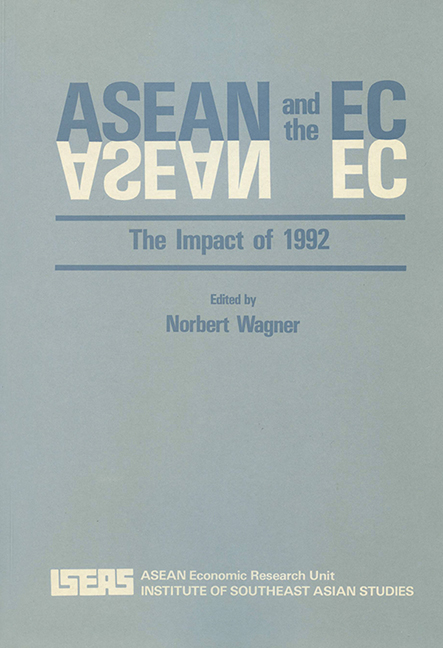Book contents
- Frontmatter
- Contents
- List of Tables
- List of Figures
- Acknowledgements
- PART I INTRODUCTION
- PART II COMPLETING THE EC INTERNAL MARKET
- PART III IMPLICATIONS FOR ASEAN
- V An Analysis of ASEAN-EC Trade in Textiles and Electronics, 1980–88
- VI The EC Internal Market and the ASEAN Electronics Industry
- VII The EC Internal Market and the ASEAN Textile and Clothing Industry
- VIII The Harmonization of Technical Standards and Regulations in the EC: Implications for ASEAN
- IX The EC Internal Market and ASEAN-EC Trade in Services
- X The EC Internal Market and ASEAN-EC Direct Investment Flows
- XI The European Currency System and ASEAN
- Contributors
VI - The EC Internal Market and the ASEAN Electronics Industry
from PART III - IMPLICATIONS FOR ASEAN
Published online by Cambridge University Press: 09 November 2017
- Frontmatter
- Contents
- List of Tables
- List of Figures
- Acknowledgements
- PART I INTRODUCTION
- PART II COMPLETING THE EC INTERNAL MARKET
- PART III IMPLICATIONS FOR ASEAN
- V An Analysis of ASEAN-EC Trade in Textiles and Electronics, 1980–88
- VI The EC Internal Market and the ASEAN Electronics Industry
- VII The EC Internal Market and the ASEAN Textile and Clothing Industry
- VIII The Harmonization of Technical Standards and Regulations in the EC: Implications for ASEAN
- IX The EC Internal Market and ASEAN-EC Trade in Services
- X The EC Internal Market and ASEAN-EC Direct Investment Flows
- XI The European Currency System and ASEAN
- Contributors
Summary
Introduction
Among the factors leading to the creation of an European internal market the most important is probably the growing perception that Europe was lagging behind the United States and Japan in terms of technological development and world market shares for high-tech products (Wagner 1989, p. 5).
Nowhere is this European concern for being left behind more powerfully manifested than in the electronics industry. Throughout Europe, there is a growing consensus that the electronics industry in general and more particularly the information technology (IT) industry that it encompasses is fundamental to the industrial survival of Europe for the next century. Widespread fear has been expressed in many quarters that Europe is losing the IT race to the United States and Japan, and that this necessitates nothing short of a concerted pan-European response involving a major restructuring of existing firms and massive co-ordinated government-supported programmes to enable Europe to catch up (see, for example, MacKintosh 1986 and Von Gizycki and Schubert 1984). The creation of a single internal EC market thus represents a major — though not the only — element of this pan-European strategy to revive Europe's competitiveness in the electronics industry. Indeed, the EC electronics industry has been leading the overall EC private sector in its campaign for the completion of the internal market, and has been largely instrumental in the creation of the various major pan-European co-operative projects in research and development (R&D) in the electronics-related technology (such as the European Strategic Programme of Research in Information Technology [ESPRIT], Research in Advanced Communication Technologies for Europe [RACE], European Research Co-ordination Agency [EUREKA], Basic Research in Industrial Technologies for Europe [BRITE], and Joint European Submicron Silicon [JESSI]).
While the impending creation of a single, unified EC market after 1992 provides a very important framework that guides and influences the future restructuring strategy of the European electronics industry, it must be recognized that significant restructuring and transformation of the industry has in fact been taking place over the last few years, and that various major EC-wide and individual Member State government policies related to the industry have been put in place prior to, and in some cases, independent of, the Single Market Act.
- Type
- Chapter
- Information
- ASEAN and the ECThe Impact of 1992, pp. 153 - 189Publisher: ISEAS–Yusof Ishak InstitutePrint publication year: 1991



